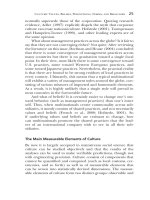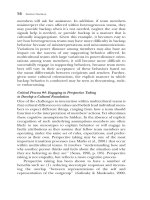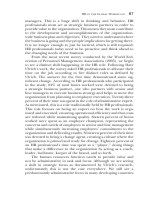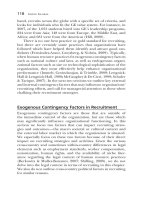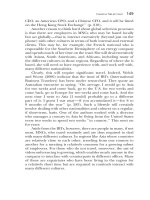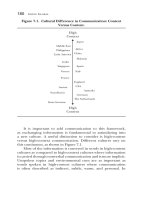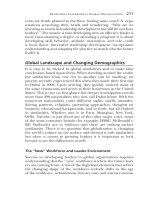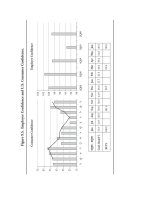Going Global Practical Applications and Recommendations for HR and OD Professionals in the Global Workplace J-B SIOP Professional Practice Series by Kyle Lundby, Jeffrey Jolton and Allen I. Kraut_13 potx
Bạn đang xem bản rút gọn của tài liệu. Xem và tải ngay bản đầy đủ của tài liệu tại đây (537.25 KB, 28 trang )
Best Practices for Training Intercultural Competence 299
Mitchell, T. R., & Foa, U. G. (1969). Diffusion of the effect of cultural
training of the leader in the structure of heterocultural task groups.
Australian Journal of Psychology, 21, 31–43.
Montagno, R. V. (1996). Integrated cross-cultural business training.
Journal of Management, 15(4), 57–61.
O’Brien, G., Fiedler, F., & Hewett, T. (1971). The effects of programmed
culture training upon the performance of volunteer medical teams
in Central America. Human Relations, 24(3), 209–231.
Puck, J. F., Kittler, M. G., & Wright, C. (2008). Does it really work?
Re-assessing the impact of pre-departure cross-cultural training on
expatriate adjustment. The International Journal of Human Resource
Management, 19(12), 2181–2197.
Pulakos,E.D.,Schmitt,N.,Dorsey,D.W.,Arad,S.,Hedge,J.W.,&
Borman, W. C. (2002). Predicting adaptive performance: Further
tests of a model ofadaptability. Human Performance, 15(4), 299–323.
Rahim, M. A. (1983). A measure of styles of handling interpersonal
conflict. Academy of Management Journal, 26, 368–376.
Rodriguez, R. (2009, July). Incorporating global diversity into learning.
Chief Learning Officer, 47–49.
Ruben, B. D. (1976). Assessing communication competency for intercul-
tural adaptation. Group & Organization Studies, 14(3), 334–354.
Sanchez-Burks, J. (2005). Protestant relational ideology: The cognitive
underpinnings and organizational implications of an American
anomaly. In R. Kramer & B. Staw (Eds.), Research in organizational
behavior (Vol. 26, pp. 267–308). New York: Elsevier.
Sanchez-Burks, J., Lee, F., Nisbett, R., & Ybarra, O. (2007). Cultural
training based on a theory of relational ideology. Basic and Applied
Social Psychology, 29, 257–268.
Schendel, J., & Hagman, J. (1982). On sustaining procedural skills
over prolonged retention interval. Journal of Applied Psychology, 67,
605–610.
Schoenfeld, A. (1985). Mathematical problem solving.SanDiego,CA:
Academic Press.
Selmer, J., Torbiorn, I., & Leon, C. (1998). Sequential cross-cultural
training for expatriate business managers: Predeparture and post-
arrival. International Journal of Human Resource Management, 9(5),
831–840.
Sercu, L. (2004). Assessing intercultural competence: A framework for
systematic test development in foreign language education and
beyond. Intercultural Education, 15(1), 73–88.
300 Going Global
Shen, J., & Lang, B. (2009). Cross-cultural training and its impact
on expatriate performance in Australian MNEs. Human Resources
Development International, 12(4), 371–386.
Sorcher, M., & Spence, R. (1982). The interface project: Behavior
modeling as social technology in South Africa 1. Personnel Psychology,
35(3), 557–581.
Stanhope, V., Solomon, P., Pernell-Arnold, A., Sands, R., & Bourjolly, J.
(2005). Evaluating cultural competence among behavioral health
professionals. Psychiatric Rehabilitation Journal, 28(3), 227–233.
Summers, G. J. (2004). Today’s business simulation industry. Simulation
&Gaming, 35(2), 208.
Thomas, D. C. (2006). Domain and development of cultural intelligence:
The importance of mindfulness. Group & Organization Management,
31(1), 78.
Thomas, D. C., & Inkson, K. (2004). Cultural intelligence: People skills for
global business. San Francisco: Berrett-Koehler.
TRADOC Culture Center (2009, March). Classes on culture.Pamphlet
distributed at the 2009 Culture Education and Training Summit.
Triandis, H. C. (1994). Culture and social behavior. New York: McGraw-Hill.
Waxin, M., & Panaccio, A. (2005). Cross-cultural training to facilitate
expatriate adjustment: It works! Personnel Review, 34(1), 51–67.
Whaley, A. L., & Davis, K. E. (2007). Cultural competence and evidence-
based practice in mental health services: A complementary
perspective. American Psychologist, 62(6), 563–574.
Worchel, S., & Mitchell, T. R. (1972). An evaluation of the effectiveness
of the culture assimilator in Thailand and Greece. Journal of Applied
Psychology, 56, 472–479.
Zakaria, N. (2000). The effects of cross-cultural training on the accul-
turation process of the global workforce. International Journal of
Manpower, 21(6), 492–510.
CHAPTER 11
Creating Infectious
Change in Global
Organizations: Applying
Psychology to Large-Scale
Planned Interventions
Paul M. Mastrangelo
A large-scale intervention for changing employee behaviors is
daunting in any organization, but for a multinational organization
the challenges are complicated by sheer numbers, geographical
distance, and societal cultures. Globalization means more employ-
ees working in locations far away from corporate headquarters,
where they speak different languages, experience different cul-
tures, and express different customs. Indeed, the organization
is a network of diverse social groups;yet,eachgroupcontains
similar individuals in terms of purpose, experiences, skills, lan-
guage, and so on. Therefore, holistic organizational change can
be greatly accelerated if interventions are designed according to
three principles:
1. Organizational change is the sum of individual employees’
behavioral changes.
2. Individuals change their own behavior in predictable ways,
and so environments can be designed to promote individual
behavioral change.
301
302 Going Global
3. The rate of individual employee change can be exponential
if changes are perceived as the norm across relevant social
networks within the organization, starting with early adopters
and spreading virally because of psychological conditions.
With these underpinnings, this chapter explores (a) why
‘‘change’’ has become increasingly important for organizations,
(b) how employee survey data can guide organizational change
efforts, (c) what psychological laws of behavioral change can be
taken from social, clinical, and health psychology and applied to
organizational change efforts, and (d) what practical techniques
can interject these components to create infectious organizational
change on a global scale.
Organizational Change in Our Twenty-First
Century Global Environment
The pace of change in work environments has accelerated for
many reasons. Computer and telecommunication innovations
over the past 25 years have increased customer expectations for
the immediate satisfaction of their needs. As a result businesses
must strive to deliver ever more customized products and services
as quickly as possible. To maintain or improve cost efficiencies,
business leaders have sought partnerships, mergers, and acquisi-
tions; yet, the pressure to deliver quicker returns on investments
for stockholders has also made leaders eager to jettison units
that do not meet expectations for profit, growth, or complemen-
tary revenue. The resulting employee climate is filled with the
call for more efficient processes, accelerated time lines, and cus-
tomized solutions even in the most stable organizations, which
are rare. Large organizations are continuously reorganizing work-
groups. Indeed, it is practically essential to prepare a workforce
for change. Yet this accelerated pace has indirectly brought about
conditions that complicate organizational change: globalization,
multishoring, and geographically matrixed organizations compli-
cate OD interventions designed to create company-wide changes
in employee behaviors.
To be clear, I use the term ‘‘large-scale planned interventions’’
to refer to changes that are driven from the top level of the
Creating Infectious Change in Global Organizations 303
organization (but not necessarily executed from the top) and
that are meant to affect all employees (but not necessarily in
the same manner). Often multinational organizations undertake
such interventions after administering a global employee survey
(Kraut, 1996; 2006; Falletta & Combs, 2002). Although an
employee survey does not elicit the desired change in itself, it
does provide helpful antecedents. The process of creating the
content of the survey can help top leaders clarify goals and
strategy. As a result the survey provides downward communication
regarding what topics are important to the organization.
Obviously, the survey also creates upward communication, giving
top leadership feedback on levels of employee engagement
(that is, emotional commitment, intention to stay, discretionary
effort), perceptions of critical processes that drive engagement
(such as leadership, execution, talent development), and
insights into employees’ readiness for change. Furthermore,
the employee survey provides an organizational metric, which
(likeotherperformanceindicators)canbecomparedto
external benchmarks and used to establish an internal baseline
for future evaluations. Though it is not the intention of this
chapter to review methods of conducting and analyzing a global
employee survey (see Chapter 9; Mastrangelo, 2008; Scott &
Mastrangelo, 2006; Johnson, 1996), there are two aspects of
employee survey research pertinent to global organizational
change: (1) societal differences in employee perceptions and
expectations of their work environment, and (2) topics where
employee dissatisfaction should create increased readiness
to change.
Societal Differences in Employees’ Work Perceptions
and Expectations
There is a body of evidence suggesting that employees’ per-
ceptions of their work environment depend upon the society to
which they belong (Hofstede, 1980; 2001; House, Hanges, Javidan,
Dorfman, & Gupta, 2004). Generally speaking, employees who
share the same language, religion, and geography tend to have
more similar perceptions and values. The comprehensive GLOBE
study conducted by House and associates between 1994 and 1997
304 Going Global
found that countries could be grouped into 10 societal clusters
according to similar cultural outlooks on the work environment.
Predominantly English-speaking nations formed an Anglo cluster,
German-speaking nations formed a Germanic cluster, south Asian
nations were distinct from Confucian Asian nations, and so on.
Each societal cluster was found to have a fairly distinct pattern
of employee perceptions (what is) and expectations (what should
be) regarding how work gets done. These patterns were based on
nine dimensions:
1. Assertiveness: Assertive, confrontational, aggressive in social
relationships
2. Future Orientation: Plan, invest in the future, delay gratifications
3. Gender Egalitarianism: Minimize gender role differences, pro-
motion of gender equality
4. Humane Orientation: Reward being fair, altruistic, friendly, gen-
erous, caring, and so on
5. In-Group Collectivism: Express pride, loyalty, and cohesiveness
in their organizations or families
6. Institutional Collectivism: Encourage or reward collective distri-
bution of resources and collective action
7. Performance Orientation: Reward performance improvement or
excellence
8. Power Distance: Believe power should be stratified and concen-
trated at higher levels
9. Uncertainty Avoidance: Avoid uncertainty, rely on established
social norms, rituals, and bureaucratic practices
The GLOBE study suggests that Eastern European and Middle
Eastern societies are similar to each other, but nearly opposite
from the Germanic and Nordic societies, which tend to be similar
to each other. Latin America is similar to Latin Europe, and
southern Asia is similar to Confucian Asia. The Anglo society
(which includes the United States) tends to have moderate scores
on most dimensions, serving as a midpoint between Europe and
Asia. Yet, the most intriguing findings in terms of organizational
change are the societal differences found among these clusters.
Any societal variability in the gaps between perceptions of ‘‘what
is’’ and expectations of ‘‘what should be’’ hypothetically should
Creating Infectious Change in Global Organizations 305
lead to societal variability in inclinations to change behavior.
Consider some of the patterns discovered:
• Employees from most societies had perceptions that matched
their expectations in terms of in-group collectivism (that
is pride and loyalty in organizations and families), with the
notable exceptions of Anglo and Nordic societies, both of
which perceived less in-group collectivism than what they
thought should be.
• Employees from all societies, but especially southern Asia,
perceived more power distance (that is, separation between
a supervisor and a subordinate) than what they thought
should be.
• All societies observed less performance orientation than they
thought should exist, but the gap was smallest for Confucian
Asia and largest for Latin America.
• The Nordic society was the only one to report more institutional
collectivism than what they thought should be.
• The Germanic society was the only one to report more assertive-
ness than what they thought should be.
• The Nordic and Germanic societies were also the only ones
to perceive more uncertainty avoidance (that is, reliance on
bureaucracy, ritual) than what they thought should be, con-
trasting sharply with Middle Eastern and Eastern European
societies.
• The Nordic and Germanic societies were most favorable among
perceptions of future orientation, whereas Eastern Europe,
Latin America, and Middle Eastern societies observed less than
what they thought should be.
• Southern Asian countries had more favorable perceptions of
humane orientation than did the other societies.
• The Middle East had the lowest expectations for gender
egalitarianism, and their perceptions matched that low level,
suggesting that their ‘‘satisfaction’’ in this domain is based on
setting a lower bar than what other societies would set.
Given these findings, it may seem logical to assume that
employees’ readiness to change will vary based on these societal
differences in perceptions and expectations of work. Societies
306 Going Global
with larger gaps between perceptions and expectations should be
more dissatisfied with the status quo and thus more amenable to
change efforts that seek to close those gaps. If true, then multi-
national organizations executing planned change efforts would
experience different levels of success across locations, depending
on what specific action area is being addressed and what inter-
vention is being used. This concept produces intriguing, if not
counterintuitive, hypotheses. For example, if an organization were
to attempt to improve gender equity throughout the world, one
would hypothesize, based on these GLOBE findings, that women
in the Middle East would have very little interest in the effort. As
another example, empowerment efforts in south Asia that trans-
fer power from supervisors to employees should be welcomed
by employees, even though it is radically different from current
societal norms.
Of course, there are many reasons to doubt that societal cul-
ture moderates the efficacy of planned organizational change
initiatives—most notably the lack of empirical studies specifically
designed to test these ideas. In addition, the conclusions from
the GLOBE study are sometimes in conflict with prior findings
from Hofstede (for example, the universal finding that employees
perceive more power distance than what they think should be
contradicts Hofstede’s conclusion that Latin and Asian societies
prefer more power distance). Such inconsistencies may be due to
the various methodological differences between the two studies
or to changes in work perceptions across cultural societies in
the past 25 years. Finally, one must also be careful not to erro-
neously apply cultural level results to the individual level (the
Ecological Fallacy). A person’s immediate psychological environ-
ment is far more predictive of that individual’s behavior than
is the ‘‘average’’ for his or her society. Even when a society’s
average is lower than the global average, an individual from that
society may surpass the global average. Indeed, for developing
societies, multinational companies may employ people who dif-
fer substantially from their societal norms (for example, better
educated, higher socioeconomic status). To that point, my col-
leagues and I have not been able to conceptually replicate results
from the GLOBE study when using specific organizational survey
results, leading us to conclude that the organizational culture of
Creating Infectious Change in Global Organizations 307
a multinational company can trump the societal culture that pre-
sides at a given location (Mastrangelo, Johnson, & Jolton, 2005;
Mastrangelo & Corace, 2006; Mastrangelo, 2008). HR and OD
practitioners engaged in global change efforts are advised to be
aware of societal differences, but not to let these broad generalities
overrule specific data relevant to the situation.
Topics Where Employee Dissatisfaction Should Create
Increased Readiness to Change
To the extent that employee surveys measure dissatisfaction with
facets of an organization’s climate, they should also indicate
where employees are most ready to change. According to the DVF
‘‘Change Equation’’ (D × V × F
>
R) (Holman & Devane, 1999;
Torgeson-Anderson, Gantner, & Hanson, 2006), Dissatisfaction
is one of three necessary elements (along with Vision and First
Steps) that must interact to overcome Resistance and thus create
successful organizational change. Yet, experience with employee
survey data indicates that dissatisfaction on certain topics is more
important than dissatisfaction on other topics. For example, survey
questions that ask about compensation and benefits typically yield
the most dissatisfaction, but they hardly ever correlate strongly
with engagement questions, subsequent retention, or organization
performance metrics.
A review of the topics that do correspond with these outcomes
suggests that the most important areas of dissatisfaction concern
employees’ frustration in accomplishing personal and organiza-
tional goals. In a Corporate Leadership Council (2004) study of
50,000 employees from 59 companies, the survey topics that most
related to employee engagement (logical and emotional commit-
ment, intention to stay, and discretionary effort) included the link
between work and organizational strategy, supervisor effectiveness,
and communication practices. In my own analysis of a multi-
national Fortune 100 manufacturing company, the topics most
associated with ratings of the organization as a place to work were
customer orientation, quality, and successful product launches.
A third analysis from a separate multinational Fortune 500 com-
pany indicated that the best predictor of top performers who
subsequently left the company was perception of the company’s
308 Going Global
culture for improvement, including use of their employee survey
to make changes. Across disparate employee survey questions
and measures of organizational performance, the most impactful
areas are not ‘‘what’s in it for me’’ topics like compensation, but
rather topics that address business execution. Dissatisfaction with
execution is what best predicts both employee behavior (such
as turnover) and organizational behavior (such as financial per-
formance). Thus, the employees’ perceived ability to personally
contribute to their organization’s success and improvement is the
most important source of dissatisfaction for driving change.
Yet, if employees’ survey responses pinpoint their dissatisfac-
tion on topics that clearly align with what leaders want to improve,
then why is effective organizational change so elusive? There
are several possible explanations for this survey-change paradox.
Sometimes what appears to be dissatisfaction is actually not. As
previously mentioned certain survey topics (such as compensa-
tion, work-life balance) elicit high dissatisfaction as a norm, but
these expressions of dissatisfaction are typically not associated with
detrimental behavior. As one of my clients put it, some employee
survey questions are like asking your kids if they have enough toys;
you know they will ask for more even if they are completely satisfied
with what they have. If post-survey efforts only focus on apparent
dissatisfaction, but not the real sources of frustration, then the
organization loses the opportunity to create broad support for
meaningful change.
Likewise, what appears to be satisfaction or dissatisfaction can
be confused because of societal differences in employee survey
scores. Normative data show relatively high satisfaction across all
topics in Latin America and India, but low satisfaction in Japan.
Unless scores in these locations are compared to local normative
data, the expressions of satisfaction or dissatisfaction will be mis-
construed at the organizational level. The same error can take
place when comparing survey scores across job types; for example,
normative scores for manufacturing jobs are lower than those from
sales, potentially masking strengths of one location and the weak-
nesses of another. In sum, a likely reason for this survey paradox
is that employees’ survey responses are frequently misunderstood.
Yet, poor interpretation of results is not the only culprit.
Creating Infectious Change in Global Organizations 309
Another reason why employees’ dissatisfaction with the status
quo does not translate into effective organizational change is that
there is equivalent or greater dissatisfaction with the alternatives
to the status quo. Employees often prefer to maintain a known
source of dissatisfaction rather than venture into a new situation
with unknown consequences. This preference for the ‘‘evil we
know’’ has been demonstrated particularly among people with low
scores onthe personality domain Emotional Stability(for example,
highly anxious individuals) (Hirsh & Inzlicht, 2008). A similar
phenomenon occurs when employees say they want change to
occur, but are not willing to commit to their own behavioral
change. I have interviewed employees who blame leaders for
their current situation, and, therefore, they expect leaders to
deliver them. They want a change more than they want to change.
Furthermore, some employees do not believe that the desired
outcome is possible given current circumstances and previous
attempts at organizational change, leading them to give up trying
to make a difference—a phenomenon known in psychology as
learned helplessness.
To the extent that employee dissatisfaction with the sta-
tus quo is not being harnessed to improve the organization,
there is unrealized potential for successful organizational change.
Given the challenges facing a global organization in need of
changing employee behavior, this gap between dissatisfaction
and change must be bridged. The next section of the chapter
reviews evidence-based theories from clinical, health, and social
psychology that describe the conditions under which individu-
als change their behavior. Evidence-based models of individual
change will then be applied to organizational change to create
large-scale interventions that take advantage of a ‘‘crowd men-
tality’’ or ‘‘contagion’’ designed to transform dissatisfaction into
behavioral change. Simply put, changing people is about chang-
ing each individual in that population, but the rate of change
need not occur one individual at a time. Global organizational
change can be achieved more quickly and effectively if new behav-
iors are attractive (infectious) to certain individuals who are likely
to become role models of that behavior for other individuals
(self-replicating).
310 Going Global
Establishing Social Conditions Where Individuals Change
Their Own Behavior
Organizational change occurs when a critical mass of individ-
uals’ behaviors differs from time 1 to time 2. The definition
of the critical mass varies depending on the nature of what is
to be changed; success may require 100% of an organization to
change behavior, or success may be achieved at a lower percent-
age of changed behavior. A holistic change requires different
employees to make different changes. For instance, the organi-
zation seeking to improve its safety record will need adherence
to new procedures from nonsupervisory employees, vigilance and
support from direct supervisors to maintain safety compliance,
cooperation from union leaders to change disciplinary standards
for safety infractions, new performance management goals from
HR to assert Lost Workday Case as a critical leadership met-
ric, the redesign of all locations by facilities management to
reduce accident risks, and so on. Individual employees through-
out this organization will need to prepare for and engage in new
work behaviors. Successful organizational change can therefore
be defined as the aggregate of individual behavioral changes
that are appropriate given each individual’s organizational role.
Fundamentally, organizational change occurs through just two
processes: new behavior from new employees, and new behavior
from existing employees. The attraction, selection, and attrition
of employees in an organization do affect the climate or culture of
an organization (Schneider & Reichers, 1983). Likewise, orga-
nizational mergers, acquisitions, and reorganizations create new
groups, different social interactions, and heightened ambiguity
regarding behavioral expectations. However, solely changing the
human composition of an organization is not likely to yield the
desired combination of specific behavioral changes necessary for
success (although drastic staffing changes may make employees
more aware of the need to change their own behavior). Fur-
thermore, replacing or adding employees is not always a viable
option because of costs, laws, politics, and other constraints.
Focusing on how to change the behaviors of existing employ-
ees is a more fruitful path to improving organizational change
interventions.
Creating Infectious Change in Global Organizations 311
Yet, too often individual behavioral change is treated as a
‘‘black box’’ step in organizational change models. Lewin’s clas-
sic model (1951) of organizational change (Unfreeze, Change,
Refreeze) is a good example of a procedural guideline that does
not specify how behavioral changes are to occur. Even more
detailed models, such as Rothwell & Sullivan’s Change Process
Model (2005), ignore how employee behaviors will be changed.
Burke’s Action Research Model (2002) provides some guidelines
(for example, Establish the need for change, Deal with resis-
tance), but it lacks specific steps for how to achieve these goals.
More recent organizational change models approach specifics,
but they often oversimplify what it takes to change individu-
als’ behaviors. The previously mentioned DVF Change Equation
(D × V × F
>
R) seems to suggest that resistance to change is
overcome through improved communication: show employees
reasons why they should be dissatisfied with the status quo, show
them a vision of a new desirable end, and show them the first
steps toward achieving that end. Yet when one examines large-
scale public health efforts to reduce smoking, improve dietary
habits, or prevent driving under the influence of alcohol, com-
munication along these lines has not been effective. Why should
we expect better results in efforts to change employee behav-
ior? My telling you about organizational efforts to improve safety
may motivate you to happily follow new procedures, but it also
might motivate you to vigorously resist. If those new safety proce-
dures conflict with how you see yourself (helmets are for wimps),
how your boss sees you (safety procedures slow down delivery),
or how your friends see you (my workgroup burned the new fire
prevention policy), then there is a good chance that the communi-
cation, no matter howlogical, will be disregarded. Communication
must be combined with other psychological conditions in order
to create large-scale behavioral change.
A more comprehensive approach to organizational change
is found in John Kotter’s (1995; 1996) Eight-Stage Process for
Creating Major Change:
1. Establishing a sense of urgency
2. Creating a guiding coalition
3. Developing a vision and strategy
312 Going Global
4. Communicating the change vision
5. Empowering a broad base of people to take action
6. Generating short-term wins
7. Consolidating gains and producing even more change
8. Anchoring (institutionalizing) the new approaches into the
culture
Though some aspects of his process mimic the DVF Change
Equation (for example, establishing urgency is similar to creating
dissatisfaction, both models emphasize communicating vision),
Kotter does introduce actions beyond communication that create
the right psychological conditions for behavioral change. Note
that Kotter speaks about the creation of a guiding coalition and the
widespread empowerment of people. Both of these steps reference
a group of change leaders. ‘‘The solution to the change problem
is not one larger-than-life individual who charms thousands into
being obedientfollowers Manypeopleneed to help withthe
leadership task ’’(Kotter, 1996, p. 30). The implication is that
organizational change is moderated by social pressures, which
can impede or accelerate the various new behaviors necessary for
success. Furthermore, Kotter suggests that organizational change
occurs in an iterative fashion, where early success is used to bring
more people onboard to engage in still more changes.
From this point of view, organizational change can be likened
to a chain reaction or domino effect, where the number of
employees participating in behavioral changes increases exponen-
tially and the impact stretches out far from the original source of
action. Such a campaign is particularly suited to large, global orga-
nizations which need behavioral changes to occur quickly despite
great geographical distances and cultural differences. To use a
marketing analogy, this approach to organizational change is less
about broadcasting repetitive commercials to a broad audience
and is more about a viral marketing campaign, where a targeted
message is attractive to a certain group of individuals (infectious)
who then pass the message on to their peers (self-replicating).
Malcom Gladwell’s The Tipping Point (2000) describes a spon-
taneous viral event where a few influential kids from the art
scene began wearing Hush Puppies shoes, leading to waves of
other teenagers who wanted to join this fashion and a 400%
Creating Infectious Change in Global Organizations 313
increase in shoe sales. Gladwell attributes this viral behavioral
change to the interaction of three small, but critical roles being
filled: (1) Mavens, who start trends because they are highly
knowledgeable about certain topics and they like to share that
knowledge; (2) Salesmen, who are highly persuasive and therefore
can motivate others to assimilate what Mavens have discovered;
and (3) Connectors, who have a much larger than average network
of friends and acquaintances across different ‘‘circles’’ of people,
allowing them to spread what they have assimilated to vastly differ-
ent social groups. The combination of these roles allows a small
set of individuals to influence a much larger group of people, as
new behavior moves from one social network to the next.
In a workplace environment such social networks are both
formal (for example, the second shift machine operators at the
Antwerp plant) and informal (for example, the smokers who
gather outside the loading dock at 10:30). Based on their social
interactions, members of these groups develop shared meanings
of organizational events (Schneider & Reichers, 1983) and similar
perceptions of the organization (Rentsch, 1990). The influence
that members of each social network have over each other forms
the basis of subcultures within the organization. Martin & Siehl
(1983) proposed that organizations actually need multiple subcul-
tures as they help maintain a balance between sustaining current
behavior and introducing new behaviors. Some subcultures have
been found to enhance the dominant culture fervently, as mem-
bers guard traditions and established behaviors. However, other
types of subcultures act as the breeding ground for new behav-
ior. Martin and Siehl describe Orthogonal subcultures, whose
members develop new values that are tangential to the dominant
culture, and Countercultures, whose members oppose the old
norms of behavior and spur innovation.
The key to creating a global planned-change intervention is
to seed the right breeding grounds with the right self-replicating
behaviors, thus ‘‘infecting’’ the whole organization with coordi-
nated changes deemed necessary for success. The elements of
this infectious, self-replicating behavioral change are grounded in
existing evidence-based theories that designate (a) who is most
likely to initiate new behaviors that will become infectious, (b) how
perceived social norms lead individuals to conform, (c) how subtle
314 Going Global
shifts in the social environment encourage individuals to change
their own behavior, and (d) what predictable stages exist when
individuals change their own behavior.
Evidence-Based Psychological Theories of Behavioral Change
Psychological research shows that individuals change their own
behavior in predictable ways, suggesting that social environments
can be designed to promote behavioral change. The most basic
‘‘learning’’ and ‘‘motivational’’ theories are well known and fol-
low the same basic pattern. First, individuals attain feedback that
alerts them to wants and needs. They may look inwardly to real-
ize that they are dissatisfied with their current state, but often
this evaluation has a social context. Next, individuals decide to
act on one or more of these wants and needs. There is a gen-
eral tendency to satisfy basic needs (physiological, safety) before
addressing more complex needs (social, esteem, or actualization)
(Maslow, 1987). Finally, individuals take action and behave in a
manner that is intended to satisfy their wants and needs. The
actual action is selected because it has worked before (classical
conditioning, operant conditioning), it has worked for someone
else before (vicarious learning, modeling), or it seems like it
should work (expectancy, VIE). However, evidence-based psycho-
logical theories of behavioral change go beyond this foundation,
and there are four well-supported theories that can be used to
change organizations. Each is described below, and the last section
of this chapter combines elements from these theories to suggest
practical techniques for creating infectious organizational change.
Individuals Are Predisposed to Play Different Roles During
Organizational Change
In any given population there will be some individuals who are
relatively more adaptive to change, some who are more anxious
about change, some who are more influential in changing oth-
ers,andsomewhoaremorelikelytobeinfluencedtochange.
Although more complex than Gladwell’s Maven-Salesman-Connector
description, personality theory also suggests that employees have
different roles to play in an organizational change initiative.
Creating Infectious Change in Global Organizations 315
Decades of empirical research have led to the Five Factor Model
(FFM) of personality, which uses five broad domains to describe
a person’s behavioral tendencies that distinguish the individual’s
identity (see Table 11.1). Though each of these five domains can
be broken down into subparts, generally personality boils down to
a person’s degree of Extroversion, Agreeableness, Conscientious-
ness, Emotional Stability, and Openness to Experience. The FFM
has not only been rigorously validated (see, for example, McCrae
& Costa, 1987; Goldberg, 1990; Barrick & Mount, 1991), but it
also has been found applicable across multiple societal cultures
(Howard & Howard, 2001; Rolland, 2002). As a result the FFM
provides an empirically supported set of profiles or roles that can
be used to cast an infectious change.
Some individuals are prone to search for novel, unfamil-
iar experiences and would be classified as scoring high on the
Openness to Experience domain. Because these individuals are
biological recipients of more dopamine and dopamine receptors
in their brains (Howard & Howard, 2001), they display more
curiosity and exploration in their thoughts and behaviors. They
are willing to change for the sake of change, and they tend to be
bored in the absence of change. Thus, employees who are very
open to experience are more likely to adopt newly prescribed
behaviors. If these new behaviors are likely to create uncertain
consequences for the employees, then the most perseverant indi-
viduals will likely be those who are relatively high on Emotional
Stability, meaning that they tend to be calmer in stressful con-
ditions. A recent study suggests that individuals who have low
Emotional Stability have such a high need for certainty that they
actually prefer definitive bad news rather than uncertain but
possibly good news (Hirsh & Inzlicht, 2008). So, it would seem
that only certain employees are prone to be the first to change
their behavior to match a new standard, especially with uncertain
consequences for making the change.
Making these few early adopters’ changes infectious, however,
calls for two further circumstances to hold true. The first condi-
tion involves Extroversion. Some portion of these early adopters
need to be extroverted enough to be perceived as influential
(Gladwell’s salesman role), and some portion of the individuals
being influenced need to be extroverted enough to pass on the
316 Going Global
Table 11.1. The Five-Factor Model of Personality.
Personality Domain Description
Openness to
Experience
People with high scores seek what is new, think
ideally about the future, and are perceived as
imaginative, curious, and original.
People with low scores seek familiarity, think
practically about the current situation, and are
perceived as traditional, consistent, and
straightforward.
Extroversion People with high scores prefer being with
people, lead or get involved with activities, and
are perceived as talkative, assertive, and sociable.
People with low scores prefer being alone,
remain private, choose to write more than talk,
and are perceived as quiet, aloof, and serious.
Agreeableness People with high scores promote social
harmony, tend to compromise, and are
described as compassionate, tolerant, and
cooperative.
People with low scores promote their interests,
persistinanopinion,andaredescribedas
tough, independent, and adamant.
Emotional Stability People with high scores handle stress well, tend
to be rational, focus on solving problems, and
are described as calm and steady.
People with low scores react to stress with
excitement, tend to be emotional, focus on
seeing problems, and are described as anxious.
Conscientiousness People with high scores work in a linear fashion,
rely on preparation and organization, and are
described as reliable, rule oriented, and
thorough.
People with low scores work in a nonlinear
fashion, rely on spontaneity and impulse, and
are described as relaxed, flexible, and
free-spirited.
Creating Infectious Change in Global Organizations 317
new behavior to others as being worthwhile (Gladwell’s Connector
role). Extroversion marks a person’s need for sensory stimulation,
it is mostly expressed by the need to be with other people, and
it is positively related to a drive to lead other people (Howard
& Howard, 2001). It follows that the more extroverted the early
adopters are, the more likely that they will be seen as charismatic
leaders whose behavioral changes will be imitated. The same
holds true for the ‘‘early imitators’’ who first follow the leader and
replicate the behavioral change.
It is this distinction between the leader and the follower that
highlights the second condition for infectious change. Those
early adopters who are subsequently imitated are challenging the
established behavioral norm and any social pressure that exists to
maintain that norm. Likewise, many of those early imitators must
also challenge the status quo. Yet, at some point in a successful
intervention, change becomes the norm, meaning that subse-
quent imitators are not so much challenging others as they are
accommodating others. Again, the FFM indicates that individuals
have different predispositions for challenging or accommodating
others. Individuals who score lower on Agreeableness scales tend
to be more comfortable with conflict, more willing to express
their own opinions, and more apt to stand out from the crowd.
So, extroverted early adopters with below average agreeableness
have the right profile to start a small counterculture. Conversely,
individuals who score high on Agreeableness scales tend to avoid
conflict, let others ‘‘win,’’ and go with what the crowd wants. Com-
bine these tendencies with high extroversion and high openness
to experience, and you have the profile of those who can make
that counterculture more mainstream.
To create the psychological equivalent of a domino effect, one
needs some assertive individuals to push on others, but one also
needs compliant individuals who will fall into place. Although
individuals are not always consistent with their personality in all
situations, personality does represent individuals’ default tenden-
cies. As illustrated in Figure 11.1, I posit that an employee’s role in
an organizational change initiative can be predicted through the
eight possible combinations of dichotomous scores on Openness
to Experience, Extroversion, and Agreeableness. By first harness-
ing the power of Instigators to publicly change their behavior to
318 Going Global
Figure 11.1. Individual Predispositions to Organizational
Change Roles.
Low AccommodatorHigh Accommodator
High
Extroversion
Low
Extroversion
EXPLORERS
(Ready for Change)
Ambassador
Open-minded
Swing Voter
Disenfranchised
Instigator
A
D
A
P
T
E
R
S
C
H
A
L
L
E
N
G
E
R
S
Low AccommodatorHigh Accommodator
High
Extroversion
Low
Extroversion
GUARDIANS
(Change Resistant)
Fair Weather
Supporter
Skeptical
Follower
Lamenter
Resistance
Leader
A
D
A
P
T
E
R
S
C
H
A
L
L
E
N
G
E
R
S
SPOKESPERSONS
LISTENERS
influence their social networks and then relying on Ambassadors
to make this behavioral change widely acceptable, an infectious
change movement can spread from the Open-Minded Swing
Voters and the Disenfranchised to the more accommodating
Guardian groups. Though popular personality assessments (e.g.,
NEO-PI-R, Myers-Briggs Type Indicator) could be used to identify
Instigators and Ambassadors, I will discuss in the last section of this
chapter how a peer-nominated team will allow these influential
early adopters to rise to their necessary position for a successful
intervention. Given the cross-cultural validity of the FFM (Howard
& Howard, 2001; Rolland, 2002), there is no reason to believe that
these profiles would be any less useful outside the United States.
Perceived Social Norms Lead Individuals to Conform
When in Rome, you do as the Romans do. A large body of
research has demonstrated how influential a group can be on
an individual’s behavior; whether one recycles (Schultz, 1999),
laughs at a joke (Smyth & Fuller, 1972), or helps a stranger
having a seizure (Darley & Latane, 1968) depends upon the
perceived consensus of the people that surround the individual.
Robert Cialdini refers to this phenomenon as social proof—if a
group of three or more is behaving in a particular manner, other
Creating Infectious Change in Global Organizations 319
individuals are inclined to join in, especially in an ambiguous
situation (Cialdini, 2001).
There are three empirically supported explanations for why
individuals change their behavior to conform to others: accu-
racy, affiliation, and positive self-concept (Cialdini & Goldstein,
2004). Individuals rely on a group consensus to (a) accurately
interpret the situation in order to behave correctly, (b) obtain
social approval from others, and (c) enhance, protect, or repair
their self-esteem (Cialdini & Goldstein, 2004; Deutsch & Gerard,
1955). These motivations are often interrelated. Not surprisingly,
individuals are more motivated to conform when they are highly
self-conscious and their behavior is being observed by others.
Conformity also depends on aspects of the normative informa-
tion. Knowledge of the social norm needs to be salient when
the compliant behavior is to take place—any feedback about
what others are doing must either be timely or memorable in
order to affect an individual’s behavior. Furthermore, normative
information comes in two forms: descriptive norms that communi-
cate what is being done, and injunctive norms that communicate
what should be done (Cialdini, 2003; Schultz, Nolan, Cialdini,
Goldstein, & Griskevicius, 2007). Conformity is more likely when
both of these norms indicate that the same behavior is socially
approved.
Different rates of abidance with two traffic laws clearly illustrate
these principles. In all likelihood, you rarely drive on the wrong
side of the road, no matter how slow traffic is or how late for
work you are. In this case the descriptive and injunctive norms are
aligned: driving on the correct side is overwhelmingly prevalent
and in accordance with traffic law. When you do see a car on the
wrong side of the road, something about the situation (there is
an animal in the road) or about the person (the driver appears
intoxicated) communicates that this is an exception to the social
norm. Anyone driving on the wrong side of the road without just
cause would be given quick feedback via angry drivers’ horns or an
officer’s traffic citation, and the perpetrator would be perceived as
a reckless deviant. For all these reasons, there is strong social power
that keeps you driving on the correct side. On the other hand,
you are probably not as vigilant about abiding by the posted speed
limits. Given similar dangers and potential costs, why would this
320 Going Global
be? The most obvious reason is that unlike driving on the wrong
side of the road, you can easily observe many drivers exceeding the
speed limit despite posted fines and warnings—the descriptive
norm is incongruent with the injunctive norm. Furthermore,
though both the descriptive and the injunctive feedback are
provided precisely when you can choose to adjust your speed,
the descriptive norm is typically more salient than the injunctive
norm. You see many drivers exceeding the speed limit, but you see
few being caught in the act. Obeying the speed limit may actually
anger some fellow drivers who cannot quickly pass, and ‘‘slow’’
drivers are stereotypically older, more prudish citizens—not a
classification that you aspire to join. So, you drive faster than you
should, but never on the wrong side of the road—the former is
typical, the latter is just wrong.
By analyzing individuals’ motivations to conform to descriptive
and injunctive norms, it is possible to devise a ‘‘Social Norms
Marketing Campaign’’ (Schultz et al., 2007) that projects a
social environment that promotes desired behaviors. Schultz and
his associates describe a field experiment designed to reduce
household energy consumption in a Californian community by
correcting individuals’ misperceptions regarding energy use.
Based on the assumption that people overestimate the prevalence
of undesirable behavior, they correctly hypothesized that
providing written descriptive norms for energy use would reduce
consumption among above-average households. Interestingly,
they also correctly hypothesized that providing descriptive norms
would increase energy consumption among below-average house-
holds. However, they eliminated this undesirable boomerang
effect by also providing injunctive feedback. By adding nothing
more than a handwritten happy face ()orsadface()tothe
feedback, they kept below-average consumption households at
their desirable level while improving above-average consumption
households’ energy use by an average of 1.5 kilowatt hours per day.
These are impressive results given how simple the intervention
was: targets received two messages, one week apart, that provided
feedback on their energy use, the average use in their neighbor-
hood and (in half of the cases) an emoticon to express injunctive
norms. One can imagine creating a nearly identical intervention
to alter employee behaviors in an organizational setting.
Creating Infectious Change in Global Organizations 321
For global organizations, the question is whether a Social-
Norms Marketing campaign would be effective across all societal
cultures. Because part of the motivation to conform is dependent
upon individuals’ desires to maintain their self-esteem levels, it is
logical to assume that conformity techniques would be less effec-
tive on ‘‘individuals whose cultures place less of an emphasis on
self-concept positivity and related maintenance and enhancement
goals (such as Japan) ’’ (Cialdini & Goldstein, 2004, p. 605).
On the other hand, Kim & Markus (1999) noted that conformity
and nonconformity are evaluated quite differently across cultures.
Though nonconformity represents uniqueness in Western cul-
tures, it represents deviance in East Asian cultures, suggesting
that conformity tactics may be more effective in that part of the
world. Likewise, Cialdini and his associates found that when con-
sidering whether to comply with a request, participants were more
likely to base their decisions on their peers’ actions when from
a ‘‘collectivistic country’’ such as Poland than an ‘‘individualistic
country’’ such as the United States (Cialdini, Wosinska, Barrett,
Butner, & Gornik-Durose, 1999). In summary, while conformity
tactics are likely affected by cross-cultural effects, the processes
researched in the United States do appear to operate in Europe
and Asia as well. Clearly, portraying descriptive and injunctive
norms to elicit a specific behavior is best done in consultation with
those from the local societal culture.
Subtle Shifts in the Social Environment Encourage
Individuals to Change Their Own Behavior
In 1953 Edgar Schein began working at the Walter Reed Army
Institute of Research to help prisoners of war (POWs) repatriate
to the United States following the Korean conflict. There was
clear evidence that the Chinese had been able to ‘‘brainwash’’
American soldiers such that POWs were sympathetic to commu-
nist causes and had collaborated with the enemy in various ways.
Schein began to study the socio-psychological process that the Chi-
nese had used to realize these cases of attitudinal and behavioral
transformation. The results of his research, documented in his
1961 book Coercive Persuasion, were that the Chinese techniques
were actually identical to the persuasive techniques used to indoc-
trinate individuals into religious groups, schools, fraternities, and
322 Going Global
workplaces. The change model is not coercion, which implies
being forced to change, but rather coercive persuasion, which
manipulates individuals’ social interactions, uproots their pre-
vious routines, and leads to a change in their self-images that
subsequently changes their behaviors.
Schein’s change process (2007) has three principles. First,
the change agent must create disequilibrium or find where indi-
viduals are already dissatisfied, anxious, or feeling guilty. These
emotions form ‘‘Survival Anxiety’’ and are forces for change that
become a starting point for the process. Second, the change
agent must create opportunities where individuals can reestab-
lish equilibrium by learning the desired new behaviors. Because
new learning requires unlearning previous behavioral patterns,
there will be resistance to change or ‘‘Learning Anxiety.’’ Third,
change will only occur if Survival Anxiety is greater than Learning
Anxiety, which is similar to the DVF Change Equation discussed
earlier. However, a key distinction in Schein’s model (compared
to most other change models) is that escalating Survival Anx-
iety (for example, dissatisfaction) is NOT seen as a successful
method for overcoming Learning Anxiety. Rather it is Learn-
ing Anxiety that must be reduced by altering (mostly social)
sources of resistance to create ‘‘Psychological Safety’’ that allows
behavioral change to occur. Resistance is seen primarily as fear
of losing power or position, identity, group membership, and
sense of competence—all of which come from an evaluation of
individuals’ social support system.
Based on these principles, change agents in an organizational
setting can target a ‘‘captured audience’’ that is unlikely to leave.
They can introduce the new behavior in small, graduated steps
while isolating individuals from their previous social group. As a
result individuals lose social support for old behaviors, and become
immersed in the new manner of thinking—old words and terms
become associated with new meanings, old standards are altered
to create a new normal state, and the criteria for judging good
and bad are redefined. In the midst of this ambiguity, individuals
should be placed into a new social group that will reinforce the
new behavior and provide support for individuals engaging in
the behavior change.
Creating Infectious Change in Global Organizations 323
However, shifts in the use of terms, standards, evaluations and
other environmental cues need not be drastic. In fact individuals
are far less likely to resist behavioral change when they are unaware
of any change efforts (Tice, 1994). Behavior can be influenced
by very subtle alterations to the environment, such as the uneven
placement of stripes on Lake Shore Drive in Chicago to promote
braking before a dangerous curve, or the placement of fruits and
vegetables at eye level in cafeteria lines to improve nutritional
intake (Thaler & Sunstein, 2008). The more individuals can find
their own way in the process of change (rather than being told),
the more likely they are to ‘‘internalize’’ the behavior so that
it becomes a part of their self-concept (Schein, 2007). Thus,
enticing individuals to behave in a new way (without making the
individual feel coerced) leads them to review their own behavior
and to adjust their self-concept accordingly. According to Diane
Tice (1992; 1994), individuals are more likely to internalize new
behaviors when:
• They are outside of their normal environment
• They are in transition points in their lives
• They are induced to behave publicly according to the desired
regime
• They are likely to interact with others who have seen them
behave according to the desired regime
• They frequently recall their own previous behavior that was con-
sistent with the desired regime
• They observe dissimilar others behaving in a manner inconsistent
with the desired regime
• They freely choose to behave according to the desired regime
• They are high self-monitors, who typically regulate their own
behavior to fit social cues
Although the workplace environment is not meant to be por-
trayed as a prisoner-of-war camp, nor organizational leaders as
brainwashers, these internalization techniques do have workplace
applications, particularly for newly merged organizations or those
emerging from crisis. Under these circumstances even the employ-
ees most reluctant to change are likely more amenable to new


